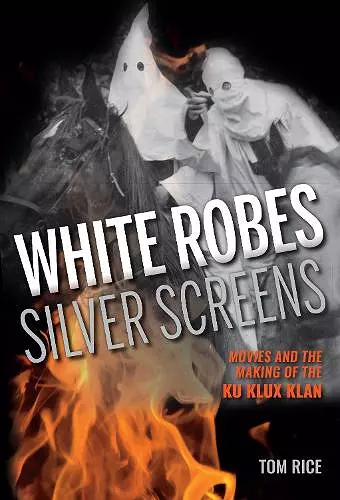White Robes, Silver Screens
Movies and the Making of the Ku Klux Klan
Format:Paperback
Publisher:Indiana University Press
Published:4th Jan '16
Currently unavailable, and unfortunately no date known when it will be back
This paperback is available in another edition too:
- Hardback£66.00(9780253018366)

Honorable Mention, 2016 INDIEFAB Award in Performing Arts & MusicRunner-up, 2017 BAFTSS Book Prize
The Ku Klux Klan was reestablished in Atlanta in 1915, barely a week before the Atlanta premiere of The Birth of a Nation, D. W. Griffith's paean to the original Klan. While this link between Griffith's film and the Klan has been widely acknowledged, Tom Rice explores the little-known relationship between the Klan's success and its use of film and media in the interwar years when the image, function, and moral rectitude of the Klan was contested on the national stage. By examining rich archival materials including a series of films produced by the Klan and a wealth of documents, newspaper clippings, and manuals, Rice uncovers the fraught history of the Klan as a local force that manipulated the American film industry to extend its reach across the country. White Robes, Silver Screens highlights the ways in which the Klan used, produced, and protested against film in order to recruit members, generate publicity, and define its role within American society.
Rice sets out how the propagandist power of the Klan has always lay in its spectacle; in its regalia, and hoods, and fiery crosses . . . Within it, for the careful reader, lies a lesson on how extremists spread their hatred under other banners today.
* The Guardian *Indeed, the book could not be timelier, given the nativist and racist rhetoric inflaming discourse among Republican Party presidential hopefuls as the 2016 American presidential campaign gathers steam. . .White Robes, Silver Screens provides an essential historical perspective on these phenomena, with lessons we would all do well to heed.
* PopMatters *Rice is alive to the irony of the Klan's simultaneous antimodernist response to film and the embrace of this influential new medium when it suited the organization . . . Rice's volume is a masterful, definitive account of this underexplored phenomenon, and it is written with a confident grasp of the complex and often contradictory forces that shape films and their place in American social history.
* Southern Jewish History *Rice offers a stimulating and fresh approach to the subject that will be of interest to scholars of the Ku Klux Klan, public memory, and the interwar period more broadly.October 2016
* H-Slavery *The Klan recognised film as a powerful medium capable of shaping public behaviour as early as the late teens; Rice provides a well-written, coherent account of the incorporation of cinema in the organisation's politics. What is brought to the forefront by this landmark work is the pivotal role played by moving pictures in elevating the Klan to prominence in 1920s, as well as in facilitating its subsequent decline in the following decades.
* Early Popular Visual Culture *Tom Rice's fascinating book, White Robes, Silver Screens, demonstrates that the engagement between the 1920s Invisible Empire and the nascent culture of film was deeper, longer-lasting, and more complicated than an evanescent spark of inspiration from popular culture that energized an emerging social movement. Rice . . . brings the perspective of his discipline along with deep and wide-ranging research in Klan and film industry sources to assemble the first comprehensive history of the place of film in the second Ku Klux Klan period from 1915 until the dissolution of the hooded order in 1944.
* Civil War Book Review *Rice's study of the complex, mutual development of the modern Ku Klux Klan and the American film industry, visual culture, and politics is a benchmark example of the contribution film studies can make to our understanding of American history.
* Indiana Magazine of History *Rice makes good use of film-related archives. He also has done impressive research in dozens of small-town newspapers, culling information about advertising, the exhibition of moving pictures, and reception in diverse communities. Rice also thoroughly examines the Klan's print media that warred against Hollywood and aligned the hooded order with mainstream censors who wanted to 'clean up' the film industry.
* Journal of American History *White Robes, Silver Screens redefines our understanding of the relationship of the Ku Klux Klan to film . . . essential reading for anyone interested in the Klan of the 1920s.
* The Journal of American HistoISBN: 9780253018434
Dimensions: unknown
Weight: 422g
312 pages